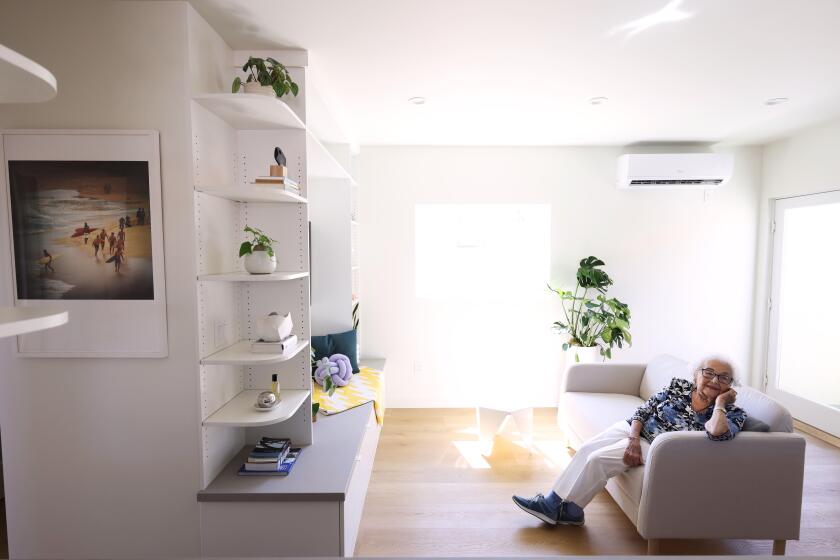The glory that was Hollywood before it became Hollyweird returns to the Hollywood Roosevelt Hotel
I drove out to Hollywood the other day to see if B. Dalton’s bookstore had a copy of “The Last Tycoon,” F. Scott Fitzgerald’s unfinished novel (they did), and stopped in to see the renovated Hollywood Roosevelt Hotel.
Anyone who thinks that Hollywood Boulevard is dead should pay the Roosevelt a visit.
It gleams with newness, and inspires with spacious vaulted rooms, period grandeur, and a haunting memory of Hollywood past.
The elaborate coffered ceiling of the lobby has been thoroughly restored, and a three-tiered fountain splashes at the center under the original chandelier.
Somebody must have had faith in Hollywood: The purchase and renovation of the hotel, according to a brochure I picked up, cost $35 million.
If Franklin Delano Roosevelt wasn’t a favorite of yours, don’t let that stop you. The hotel was built in 1926, in the Golden Era of Los Angeles architecture, and it was named after Teddy Roosevelt, not Franklin.
I walked into the dining room. It was bright and elegant, with pink napery on the tables. A young woman came toward me smiling.
“I’m just looking,” I told her. “At the renovation. It’s beautiful.”
“Yes,” she said. “We want it to be Holly wood again--not Holly weird .”
I walked up tile and terra-cotta stairs to the mezzanine and looked down at the lobby glowing under the chandelier. Around the walls of the mezzanine they had hung a historical exhibition--the story of Hollywood in--what else?--pictures.
I walked slowly around it, stopping before the images that were still so touching:
--The wonderful facade of the Egyptian Theater, before its fragmentation. It had been built in 1922, the year King Tutankhamen’s tomb was discovered, at the height of the Egyptian craze that swept America.
--The upstairs Montmartre, also built in 1922, where Valentino danced, Bing Crosby sang with the Rhythm Boys, Gloria Swanson lunched, and Joan Crawford often won the Charleston contests at the tea dansants.
--The Trocadero, Ciro’s and the Mocambo, which was described as “a cross between Imperial Rome, Salvador Dali and a bird cage.”
It was Ciro’s, wasn’t it, where the irrepressible trickster Jim Moran, dressed as an Arab prince, spilled a handful of fake diamonds on the floor to watch the locals grovel?
--The Hollywood Canteen, converted from a barn at Sunset and Cahuenga. At its wartime peak, it was visited by 100,000 servicemen a month. Danny Kaye, Red Skelton, Kay Kyser and Rudy Vallee entertained for free, and Rita Hayworth, Bette Davis or Marlene Dietrich might be found washing dishes in the kitchen.
--D. W. Griffith’s massive outdoor set for “Intolerance.” He re-created Babylonia right here in Hollywood, complete with slaves and dancing girls.
--The talkies. What a shock to the silent world of motion pictures!
“Al Jolson sings!” . . . “Harold Lloyd talks!” Many scoffed, but Fortune magazine declared: “Beyond comparison the fastest and most amazing revolution in the whole history of industrial revolution.”
In the beginning Hollywood had been called “La Nopalera,” meaning “cactus patch,” after the nopal cactus that grew abundantly on its hills. It was pioneered by a Kansas prohibitionist, Harvey Henderson Wilcox. He subdivided a tract in the Cahuenga Valley and sold the lots to Midwestern friends who practiced his Methodist morality. His wife, Daeida, named it Hollywood.
Midwestern morals went down the drain in the early 1900s when 5-cent movie theaters called nickelodeons became the rave. Dozens of these “theaters” appeared overnight in storefronts. Patrons paid a nickel to get in and sit on camp chairs to watch jerky briefs on a white sheet, with no ventilation.
--The Garden of Allah, a group of cottages built around a bar and pool in 1921 by Alla Nazimova, and frequented by such illustrious revelers as Orson Welles, F. Scott Fitzgerald, Ramon Navarro, Clara Bow, Leopold Stokowski, Gene Fowler, Robert Benchley and Charles Butterworth. I’d rather have spent an hour at that bar than in the arms of Helen Twelvetrees. (But I’d hate to have had to make that choice.)
I wanted to take some notes but found that I didn’t have a notebook. I didn’t even have an envelope to write on. I walked into a small office where a woman was just starting to make a phone call. She put the phone down and looked up.
“I wonder if you’d be good enough to give me a scrap of paper,” I said. “I’d like to take some notes on the exhibition.”
She riffled through a drawer and pulled out an unused remnant of a stenographer’s notebook.
“Is this all right?” she asked.
She was as pleasant as the hostess had been in the dining room. I got the impression that these people were really trying to make Hollywood hospitable.
On the sidewalk, as I left the hotel, I stepped on the star of Lily Pons. I walked to my car and drove a few blocks down the boulevard to Musso & Frank, which had also been in the exhibition. It was a survivor, too. It had been in the same location since 1919, and still had the same wooden booths. In the 1930s it had been much frequented by Fitzgerald, Faulkner, Hemingway, Benchley and other famous writers who had been lured to Hollywood to write for the movies.
I parked in back and went in and sat at the counter and had the chicken salad.
I looked around for Scott and Papa and Bob and any other of my heroes that might be there, but I didn’t see anyone I knew.
I guess there’s a new crowd now.
More to Read
Sign up for The Wild
We’ll help you find the best places to hike, bike and run, as well as the perfect silent spots for meditation and yoga.
You may occasionally receive promotional content from the Los Angeles Times.






